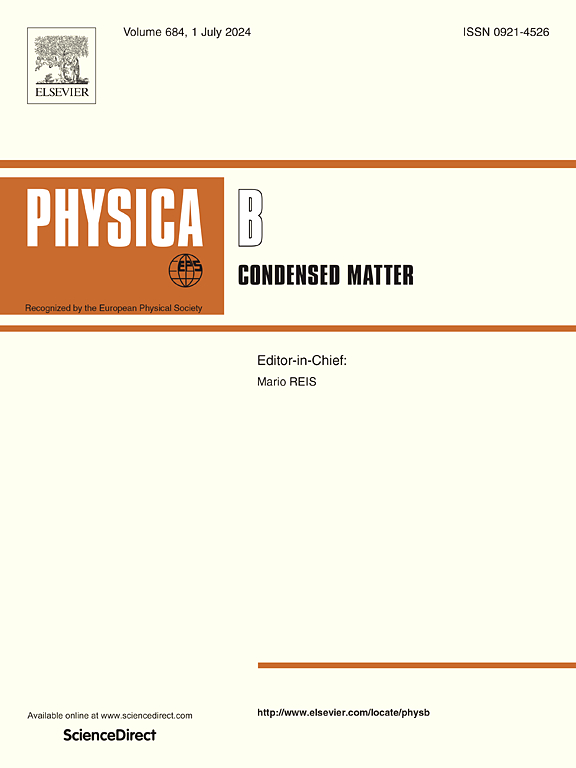用DFT和NCI分析了C3N3薄膜对NH3和H2S的吸附和传感器性能
IF 2.8
3区 物理与天体物理
Q2 PHYSICS, CONDENSED MATTER
引用次数: 0
摘要
能够精确和有选择地检测危险化合物,特别是氰化物和氟化物的传感器的发展正在稳步增长。本研究利用密度泛函理论(DFT)技术研究了氮化碳(C3N3)薄片对NH3和H2S的传感能力。相互作用能分析表明H2S与C3N3片形成了强键,可能是化学键。另一方面,NH3通过弱范德华力(vdW)吸附在表面上。为了充分理解NH3和H2S与C3N3层的成键相互作用,我们采用了非共价相互作用(NCI)、自然键轨道电荷转移(QNBO)和前沿分子轨道(FMO)。NH3@C3N3和H2S@C3N3配合物的ΔEints分别为−44.16和−58.19 kJ mol−1。NH3和H2S分析物在与C3N3薄片相互作用时,其带隙能(Eg)在FMO测量中表现出显著差异,范围在3.59 ~ 2.42 eV之间。这表明存在健壮的nci。此外,NCI-RDG分析证实了配合物中存在nci。NH3@C3N3化合物的恢复时间较短,为2.428 × 10−6 s,简化了解吸过程。单分子层对分析物的显著选择性,以及潜在的发现,将为实验人员利用C3N3薄片构建极其灵敏的NH3和H2S传感器提供实用建议。本文章由计算机程序翻译,如有差异,请以英文原文为准。
The adsorption and sensor properties of NH3 and H2S on the C3N3 sheet by DFT and NCI analysis
The surge in the development of sensors that can precisely and selectively detect dangerous compounds, especially cyanides and fluorides, is growing steadily. In present study, sensing capability of a carbon nitride (C3N3) sheet was examined for accurately detecting NH3 and H2S applying a density functional theory (DFT) technique. Analysis of interaction energy indicates that H2S forms a strong bond with the C3N3 sheet, likely due to chemical bonding. On the other hand, NH3 is adsorbed onto surface through poor van der Waals (vdW) forces. To fully comprehend bonding interactions of NH3 and H2S with the C3N3 layer, non-covalent interaction (NCI), natural bond orbital charge transfer (QNBO), and frontier molecular orbitals (FMO) have been employed. The ΔEints for the NH3@C3N3 and H2S@C3N3 complexes were determined to be −44.16 and −58.19 kJ mol−1, respectively. The NH3 and H2S analytes, when interacting with the C3N3 sheet, show notable differences in their band gap energy (Eg) during the FMO measurement, ranging from 3.59 to 2.42 eV. This indicates existence of robust NCIs. Furthermore, presence of NCIs among complexes has been verified by NCI-RDG analysis. The NH3@C3N3 compound has a brief recovery time of 2.428 × 10−6 s, which simplifies the desorption process. The significant selectivity of a monolayer towards analytes, together with the potential findings, will offer practical recommendations to experimentalists for constructing extremely sensitive sensors for NH3 and H2S utilizing a C3N3 sheet.
求助全文
通过发布文献求助,成功后即可免费获取论文全文。
去求助
来源期刊

Physica B-condensed Matter
物理-物理:凝聚态物理
CiteScore
4.90
自引率
7.10%
发文量
703
审稿时长
44 days
期刊介绍:
Physica B: Condensed Matter comprises all condensed matter and material physics that involve theoretical, computational and experimental work.
Papers should contain further developments and a proper discussion on the physics of experimental or theoretical results in one of the following areas:
-Magnetism
-Materials physics
-Nanostructures and nanomaterials
-Optics and optical materials
-Quantum materials
-Semiconductors
-Strongly correlated systems
-Superconductivity
-Surfaces and interfaces
 求助内容:
求助内容: 应助结果提醒方式:
应助结果提醒方式:


